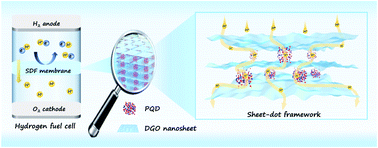Sheet-dot-framework membrane towards efficient proton conduction and outstanding stability†
Abstract
Lamellar membranes (e.g., graphene oxide (GO) membranes) are promising for ion or molecule transfer and separation, but limited by their weak structural stability and severe transfer anisotropy. Herein, we report the fabrication of a sheet-dot-framework (SDF) membrane to solve the above problems through the in situ microwave-assisted polycondensation method. Polydopamine-modified GO (DGO) nanosheets are stacked into highly ordered laminates, wherein polymer-like quantum dots (PQDs) uniformly cross-link with the adjacent DGO nanosheets through covalent bonds to construct a unique SDF structure. Conductive PQDs work as bridges for efficient cross-layer proton conduction and thus afford significantly enhanced vertical proton conductivity and reduced transfer anisotropy. Specifically, the vertical conductivity of the SDF membrane reaches 54.6 mS cm−1 at 80 °C and 100% RH, over 10 times higher than that of the DGO membrane and close to that of a state-of-the-art Nafion membrane, while the transfer anisotropy coefficient decreases to 2.5, surpassing that of most reported GO-based membranes. This then permits a 208% improvement in device output power. Importantly, the ordered covalent framework offers outstanding structural and operational stability, with great potential in practical applications. To the best of our knowledge, this study is the first example of constructing sheet-dot-framework materials, paving the way for the rational design of next-generation transport and conduction materials.



 Please wait while we load your content...
Please wait while we load your content...